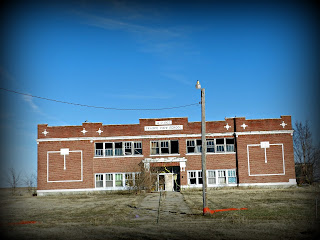Some mornings I wake up to imagine I hear car and camera
calling me to join them for another Kansas road trip. Coffee mug in its holder
and hands at 10 and 2 on the wheel, I’m ready to explore dusty roads and fading
communities along rural highways designed to knit together regions of our
state. These journeys help me
appreciate hardy souls who built homes, businesses, churches, and schools with their
hard-earned cash. Early pioneers had no access to federal or state-funding
modern residents take for granted. As a retired teacher, I’m drawn to aged
academic buildings like iron filings to a magnet.
Lately, I’ve visited a number of dilapidated towns to photograph
deteriorating schools before they vanish from the landscape. Local historical
societies have pictures of these brick wonders in their glory days, but I want
to record the moments before they return to dust. Something about a once
elegant structure in crumbling ruins captures my imagination more completely
than reading old yearbook essays does.
Certainly, I feel nostalgic as I ramble around foundations to
sense the layout of classrooms, auditoriums, and gymnasiums. Even more than a
longing for a less complicated, slower-paced existence, I ache for that time
when people incorporated handcrafted details to beautify a simple public
building. Almost every one of these deteriorating edifices is exactly that—an
edifice. In a region distant from
specialty guilds and artisans, who would complain about city leaders assembling
unassuming structures with no embellishments? Visit these ruins, and it’s clear
that is not what happened.
Many of the red brick establishments that remain were the
community’s second or third school. Oftentimes, initial coursework took place
in either a local home or dugout. As soon as a settlement developed sufficiently
to afford new construction, workers erected out of wood or native stone two or
three stories that each contained only one or two classrooms. Photos reveal modest
playgrounds and necessary houses either to the side or behind these schools. What
you see in these black and white photographs is pure function. Ornament is
missing.
By the late teens through the thirties, communities along
the Union Pacific and Missouri Pacific Railroads optimistic about continued
growth and financial success raised new schools. Many featured then-popular Art
Deco details. Those characteristics included angular brick walls with inlaid
bands of vertical brick and a flat roof. They often display decorative geometric
panels, vertical towers, stepped piers, and casement windows. A few regal
antiques have beautiful arched, multi-paned windows above hand-carved entrance
doors. One regional building still displays distinctive scroll-shaped lights on
either side of its double doors. Just walking through such an entryway to reach
class would add intent to a youngster’s studies.
Over decades, trucks and highways replaced railroads,
resulting in a declining rural population. Decades later in the 60s, school
consolidation forced closure of too many architectural masterpieces. In a few locations,
individuals bought old buildings and turned them into homes or businesses.
Unfortunately, too often, time and lack of maintenance resulted in unsalvageable
eyesores. As bricks crumble , I hope families and museums publish their old
school’s stories.




No comments:
Post a Comment